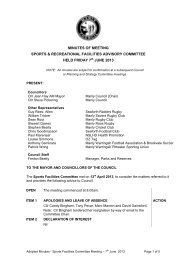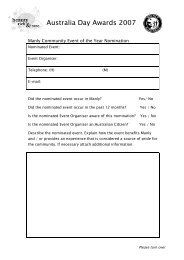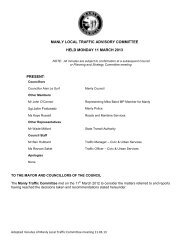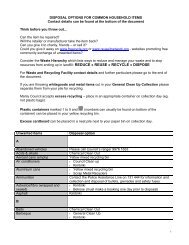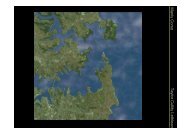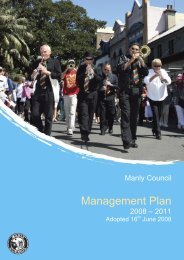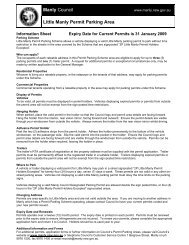Manly Lagoon Dredging Project - Manly Council - NSW Government
Manly Lagoon Dredging Project - Manly Council - NSW Government
Manly Lagoon Dredging Project - Manly Council - NSW Government
- No tags were found...
Create successful ePaper yourself
Turn your PDF publications into a flip-book with our unique Google optimized e-Paper software.
<strong>Manly</strong> <strong>Lagoon</strong> <strong>Dredging</strong> <strong>Project</strong> – Review of Environmental FactorsPrepared for <strong>Manly</strong> and Warringah <strong>Council</strong>sMonth SampledGenus Species Common NameJan93'Mar01'May01'Oct01'Feb02'Penaeus plebejus Eastern king prawn* Metapeneaus bennettae Greasyback prawn* Metapeneaus macleayi School prawn* ^ Species recorded include those caught by gill net, beach seine and beam trawl and (*) indicates species ofcommercial or recreational importance.None of the species listed in Table 5.7 are listed under the FM Act 1994 or the EPBC Act1999. One introduced pest species, Gambusia holbrooki (Mosquito Fish) was caught.A total of 45 species of fish and crustaceans have been caught in <strong>Manly</strong> <strong>Lagoon</strong>, with amaximum of 34 species in October 2001. The list of species caught includes residents thatspend much of their life cycle within the lagoon (gobies, gudgeons), those that migrateregularly between the sea and freshwater (e.g. mullet) and those that migrate fromfreshwater to the sea as adults to spawn (e.g. eels, estuary perch). The species recordedare all typical of estuarine habitats in <strong>NSW</strong> and have distributions that range throughout<strong>NSW</strong> in appropriate habitats.An additional fish survey is being undertaken by Cardno Ecology Lab during June 2010, andthis will serve as a more recent baseline of abundance and diversity of fish representative ofwinter conditions before dredging. Subsequent surveys are scheduled for the post-dredgingperiod (assuming dredging is completed in the 2010 calendar year).Benthic FaunaA benthic fauna survey was undertaken by Cardno Ecology Lab (2009b; Appendix F) in July2009. Results indicated that the distribution of individual benthic fauna was highly variablewithin <strong>Manly</strong> <strong>Lagoon</strong>, with 89% of all individuals found in samples from the upper portion ofthe dredging works near Nolan Reserve. There were no benthic animals in 12 of the 24samples collected and all sites sampled had a low diversity of taxa. The dominant speciesfound were polychaete worms from the families Spionidae and Sabellidae, species typical ofestuaries and not listed as threatened or endangered. The most abundant species foundwas Orthoprionospio cirriformia, a member of the polychaete family Spionidae (CardnoEcology Lab, 2009b). An earlier survey (The Ecology Lab 2002) also found low benthicdiversity in a winter survey (May 2001), with 13 of the 32 samples collected containing nobenthic fauna. In that survey the dominant taxa was a snail in the family Batillaridae,indicating that patchy distribution, shifting species dominance and low overall abundance arelikely to be typical of benthic assemblages in <strong>Manly</strong> <strong>Lagoon</strong> in the winter. Overall, theavailable data indicate that benthic communities in the lagoon have deteriorated and arepotentially dysfunctional (Cardno Ecology Lab, 2010).BirdsA terrestrial field survey, conducted by Warringah <strong>Council</strong> on 4 January 2010, wasundertaken to support this desktop study. The field survey found the birds shown in Table5.8 to be present in the survey area. A number of the birds identified are listed as protected2 July 2010 Cardno (<strong>NSW</strong>/ACT) Pty Ltd 81H:\Doc\2010\Reports.2010\Rep2580v4.doc



